
A flight surgeon is a military medical officer practicing in the clinical field of aviation medicine. Although the term "flight surgery" is considered improper by purists, it may occasionally be encountered.
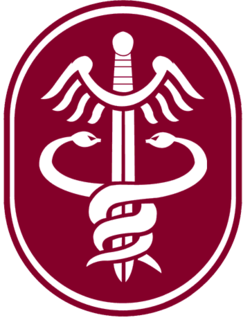
The U.S. Army Medical Command (MEDCOM) is a direct reporting unit of the U.S. Army that formerly provided command and control of the Army's fixed-facility medical, dental, and veterinary treatment facilities, providing preventive care, medical research and development and training institutions. On 1 October 2019, operational and administrative control of all military medical facilities transitioned to the Defense Health Agency.

The United States Public Health Service Commissioned Corps (PHSCC), also referred to as the Commissioned Corps of the United States Public Health Service, is the federal uniformed service of the U.S. Public Health Service (PHS) and one of the eight uniformed services of the United States. The commissioned corps' primary mission is the protection, promotion, and advancement of health and safety of the general public.

The Medical Corps of the United States Navy is a staff corps consisting of military physicians in a variety of specialties. It is the senior corps among all staff corps, second in precedence only to line officers. The corps of commissioned officers was founded on March 3, 1871.
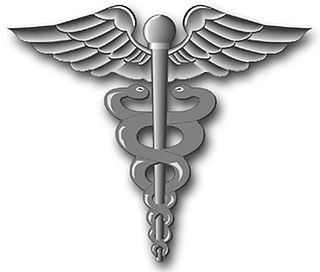
A hospital corpsman is an enlisted medical specialist of the United States Navy, who may also serve in a U.S. Marine Corps unit. The corresponding rating within the United States Coast Guard is health services technician (HS).

The Army Medical Department of the U.S. Army (AMEDD), formerly known as the Army Medical Service (AMS), encompasses the Army's six medical Special Branches. It was established as the "Army Hospital" in July of 1775 to coordinate the medical care required by the Continental Army during the Revolutionary War. The AMEDD is led by the Surgeon General of the U.S. Army, a lieutenant general.
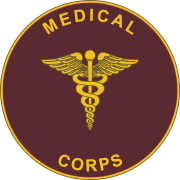
The Medical Corps (MC) of the U.S. Army is a staff corps of the U.S. Army Medical Department (AMEDD) consisting of commissioned medical officers – physicians with either an M.D. or a D.O. degree, at least one year of post-graduate clinical training, and a state medical license.
The Health Professions Scholarship Program (HPSP) offers prospective military physicians, dentists, nurse practitioners, physician assistants, optometrists, psychologists, pharmacists, and veterinarians a paid medical education in exchange for service as a commissioned medical department officer. Programs are available in the United States Army, the United States Navy, and the United States Air Force.
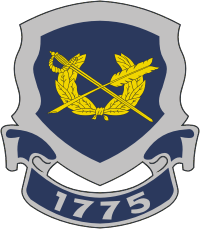
The Judge Advocate General's Corps of the United States Army, also known as the U.S. Army JAG Corps, is the legal arm of the United States Army. It is composed of Army officers who are also lawyers and who provide legal services to the Army at all levels of command, and also includes legal administrator warrant officers, paralegal noncommissioned officers and junior enlisted personnel, and civilian employees.
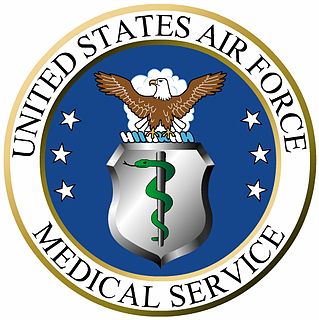
The United States Air Force Medical Service (AFMS) consists of the five distinct medical corps of the Air Force and enlisted medical technicians. The AFMS was created in 1949 after the newly independent Air Force's first Surgeon General, Maj. General Malcolm C. Grow (1887–1960), convinced the United States Army and President Harry S. Truman that the Air Force needed its own medical service.

The Surgeon General of the United States Army is the senior-most officer of the U.S. Army Medical Department (AMEDD). By policy, the Surgeon General (TSG) serves as Commanding General, U.S. Army Medical Command (MEDCOM) as well as head of the AMEDD. The surgeon general's office and staff are known as the Office of the Surgeon General (OTSG) and are located in Falls Church, Virginia.
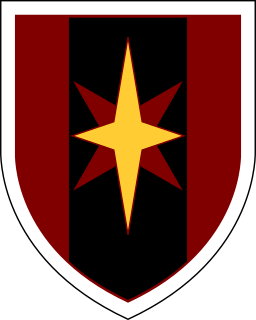
This article incorporates public domain material from websites or documents of the United States Army.

The term military medicine has a number of potential connotations. It may mean:

The U.S. Army Public Health Center (APHC) is a United States Army element headquartered at Aberdeen Proving Ground, Maryland, United States. As a forward operating agency of the United States Army Medical Command, APHC is responsible for providing technical support and expertise in the areas of preventive medicine, public health, health promotion, and wellness to military units around the globe.

The U.S. Army Medical Center of Excellence (MEDCoE) is located at Fort Sam Houston, Joint Base San Antonio, Texas. MEDCoE comprises the 32d Medical Brigade, the U.S. Army Medical Professional Training Brigade (MPTB), and the AMEDD Noncommissioned Officers Academy (NCOA). It serves the U.S. Army in educating and training all of its medical personnel. The Center formulates the Army Medical Department's (AMEDD's) organization, tactics, doctrine, equipment, and academic training support. In 2015, the mission for the Academy of Health Sciences (AHS) moved from the School to the Center, and was renamed the Department of Training and Academic Affairs (DoTAA) as result of a reorganization.

An officer is a person who holds a position of authority as a member of an armed force or uniformed service.

The 7th Medical Command provided Echelon/Role 4 Health Service Support to units of the United States Army Europe. It was a Table of organization and equipment organization that replaced the United States Army Medical Command, Europe, a Table of distribution and allowances-based organization that had provided both Role 3 and Role 4 Health Service Support from 1970 to 1978. Upon the inactivation of the 7th Medical Command in 1994, the Role 4 mission was assumed by the United States Army Medical Command through its European Health Service Support Area, while the remaining Role 3 mission was assumed by the 30th Medical Brigade.

The United States Army Medical Command, Vietnam (USAMEDCOMV) provided Echelon/Role 3 Health Service Support to units of the United States Army Vietnam (USARV). It was a Table of Distribution and Allowances organization created by consolidating the staffs of the 44th Medical Brigade and the USARV Surgeon's Office. This action was taken as part of the overall drawdown of forces in Vietnam in an effort to reduce headquarters staffs and increase efficiencies. As the medical footprint further reduced in 1972, it was replaced by the United States Army Health Services Group, Vietnam on 30 April 1972.


















